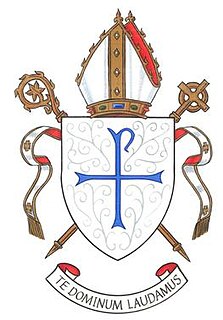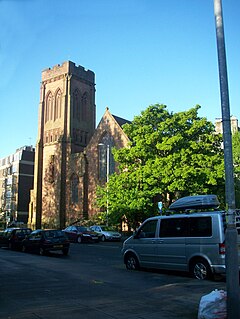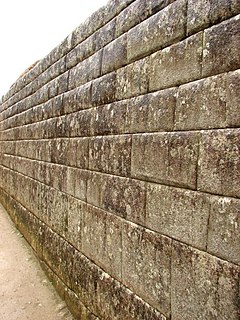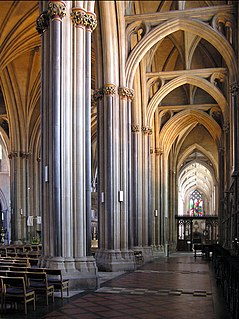
Castle Douglas is a town in Dumfries and Galloway, Scotland. It lies in the lieutenancy area of Kirkcudbrightshire, in the eastern part of Galloway, between the towns of Dalbeattie and Gatehouse of Fleet. It is in the ecclesiastical parish of Kelton.
The Bishop of Galloway, also called the Bishop of Whithorn, was the eccesiastical head of the Diocese of Galloway, said to have been founded by Saint Ninian in the mid-5th century. The subsequent Anglo-Saxon bishopric was founded in the late 7th century or early 8th century, and the first known bishop was one Pehthelm, "shield of the Picts". According to Anglo-Saxon ecclesiastical tradition, the bishopric was founded by Saint Ninian, a later corruption of the British name Uinniau or Irish Finian; although there is no contemporary evidence, it is quite likely that there had been a British or Hiberno-British bishopric before the Anglo-Saxon takeover. After Heathored, no bishop is known until the apparent resurrection of the diocese in the reign of King Fergus of Galloway. The bishops remained, uniquely for Scottish bishops, the suffragans of the Archbishop of York until 1359 when the pope released the bishopric from requiring metropolitan assent. James I formalised the admission of the diocese into the Scottish church on 26 August 1430 and just as all Scottish sees, Whithorn was to be accountable directly to the pope. The diocese was placed under the metropolitan jurisdiction of St Andrews on 17 August 1472 and then moved to the province of Glasgow on 9 January 1492. The diocese disappeared during the Scottish Reformation, but was recreated by the Catholic Church in 1878 with its cathedra at Dumfries, although it is now based at Ayr.

The Archbishop of Glasgow is an archiepiscopal title that takes its name after the city of Glasgow in Scotland. The position and title was abolished by the Church of Scotland in 1689; and, in the Scottish Episcopal Church, it is now part of the Episcopal bishopric of Glasgow and Galloway. In the Roman Catholic Church, the title was restored by Pope Leo XIII in 1878.

The Archdiocese of Glasgow was one of the thirteen dioceses of the Scottish church. It was the second largest diocese in the Kingdom of Scotland, including Clydesdale, Teviotdale, parts of Tweeddale, Liddesdale, Annandale, Nithsdale, Cunninghame, Kyle, and Strathgryfe, as well as Lennox, Carrick and the part of Galloway known as Desnes.

Whithorn Priory was a medieval Scottish monastery that also served as a cathedral, located at 6 Bruce Street in Whithorn, Wigtownshire, Dumfries and Galloway.

The Good Shepherd Cathedral in Ayr, South Ayrshire, Scotland was the cathedral church of the Roman Catholic Diocese of Galloway.

The Bishops' Conference of Scotland (BCOS), under the trust of the Catholic National Endowment Trust, and based in Airdrie, North Lanarkshire, is an episcopal conference for archbishops and bishops of the Roman Catholic Church in Scotland. The conference is primarily made up of the presiding bishops of Scotland's eight dioceses as well as bishops who have retired.

The Diocese of Glasgow and Galloway is one of the seven dioceses of the Scottish Episcopal Church. It covers Dumfries and Galloway, Ayrshire, Lanarkshire, Dunbartonshire, Renfrewshire and west Stirlingshire. The diocesan centre is St. Mary's Cathedral, Glasgow.
The Bishop of Glasgow and Galloway is the ordinary of the Scottish Episcopal Diocese of Glasgow and Galloway.

A pro-cathedral is a parish church that is temporarily serving as the cathedral or co-cathedral of a diocese or has the same function in a Catholic missionary jurisdiction that is not yet entitled to a proper cathedral, such as an apostolic prefecture or apostolic administration. It is distinct from a proto-cathedral, the term in the Roman Catholic Church for a former cathedral, which typically results from moving an episcopal see to another cathedral, in the same or another city. In a broader context, the term 'proto-cathedral' may be used of a church used by a bishop before a settled cathedral has been designated.
Elisaeus Adougan was a late 14th century and early 15th century Scottish cleric. His name has been said to have occurred for the first time in a papal letter datable to 25 November 1390, but this letter is simply a repetition of another addressed to him, dated 2 August that year; both letters address him as the rector of the parish church of Kirkmahoe, and authorise him to take up the position of provost of the Collegiate Church of Lincluden providing he resigned Kirkmahoe within a period of two years.

The Roman Catholic Diocese of Galloway is an ecclesiastical territory or diocese of the Roman Catholic Church in Scotland. The pre-Reformation Diocese of Galloway, held to have been founded by St Ninian in the fifth century, had broken allegiance with Rome in 1560, and disappeared in 1689. The territory of the modern diocese incorporates, the local authority areas of Dumfries and Galloway, South Ayrshire, East Ayrshire and parts of North Ayrshire, (Cumbrae). The bishop's cathedra is at St Margaret's Cathedral, Ayr.

St Bride's Episcopal Church is situated in the Hyndland area of the West End of Glasgow, Scotland.
All Saints' Church, St Andrews, is in North Castle Street, St Andrews, Fife, Scotland. It is an active Scottish Episcopal Church and is a Category A listed building.

Closeburn is a village and civil parish in Dumfries and Galloway, Scotland. The village is on the A76 road 2 1⁄2 miles (4 km) south of Thornhill. In the 2001 census, Closeburn had a population of 1,119. Closeburn is recorded as Killosbern in 1185. The first element of the name is Gaelic cill 'cell or church'. The second element is a saint's name, but none has definitely been identified.

St Columba's-by-the-Castle is a congregation of the Scottish Episcopal Church in central Edinburgh, Scotland. The church is located close to Edinburgh Castle, on the south slope of Castle Hill, and is protected as a category B listed building.

Gregor Duthie Duncan is an Anglican bishop, who served as Bishop of Glasgow and Galloway between 2010 and 2018.

St John the Evangelist — also known as St John's — off Crown Street is a Scottish Episcopal Church in Aberdeen, Scotland.

Church of St Mary the Virgin is a Scottish Episcopal Church, in Arbroath, Angus, Scotland. It is part of the Diocese of Brechin.























